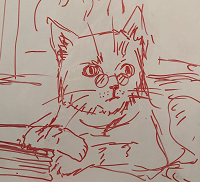1















| Thumbs Up |
| Received: 3,471 Given: 1,541 |

this sample or something similar works for the entire Balkans, the main difference is the level of Slavic admixture.
From the results we currently have, the main difference is Illyrians seem very homogenous, and changed little through time. We have 2 samples from 3500 years ago, one from 2700 years ago, and they are pretty much identical.
While Thraco-Dacian samples from Bulgaria and Moldova range from close to Neolithic farmers, to some similar to Illyrians, all the way to full Steppe samples. It seems East Balkans were more exposed to the steppe, and there were constantly new waves of Yamnaya, Corded ware, later Scythian, Sarmatian and Cimmerian settling there, so we get this huge range.
Last edited by vbnetkhio; 05-17-2020 at 01:55 PM.


















| Thumbs Up |
| Received: 6,915 Given: 7,434 |

Albanians are descended from the Illyrians of Albania not the Illyrians of Croatia.
But even if that were not the case and you have direct ancestry from Albania, you still wouldn't cluster with them because you have much more Slavic blood than they do. The groups you plot with are those that have the most similar Slavic-Balkan ratio to you.
Hmm, not sure why you're getting Hungarian at such a close distance on K36 when your K13 results show you to be distant to them. Maybe other members can explain better.Yeah here's my Eurogenes K36:
Basque 1.78 Pct
Central_Euro 6.90 Pct
East_Balkan 6.67 Pct
East_Central_Euro 14.12 Pct
East_Med 6.00 Pct
Eastern_Euro 10.40 Pct
Fennoscandian 6.94 Pct
Iberian 11.18 Pct
Italian 8.94 Pct
Near_Eastern 2.08 Pct
North_Atlantic 7.98 Pct
North_Caucasian 5.41 Pct
North_Sea 5.31 Pct
Volga-Ural 0.59 Pct
West_Med 5.68 Pct
I took out the ones with 0%, also I already made a map:
Attachment 98718

















| Thumbs Up |
| Received: 11,836 Given: 7,303 |

I realized some people in Eastern Balkans occasionally get additional Germanic-like populations in various models. It should be about Thracian-Steppe admixture rather than actual German. When I extracted my Turkic admixture and try to model my Balkan admixture, it is modeling like 60% BGR_IA, 15% German, 25% Slav. Also some Germanic hides inside of the Slavic. It actually makes sense considering where I am from.


















| Thumbs Up |
| Received: 241 Given: 130 |


















| Thumbs Up |
| Received: 241 Given: 130 |


















| Thumbs Up |
| Received: 241 Given: 130 |

Haplogroup I1 is the most common type of haplogroup I in northern Europe. It is found mostly in Scandinavia and Finland, where it typically represent over 35% of the Y chromosomes. Associated with the Norse ethnicity, I1 is found in all places invaded by ancient Germanic tribes and the Vikings. After the core of ancient Germanic civilisation in Scandinavia, the highest frequencies of I1 are observed in other Germanic-speaking regions, such as Germany, Austria, the Low Countries, England and the Scottish Lowlands, which all have between 10% and 20% of I1 lineages.

















| Thumbs Up |
| Received: 11,836 Given: 7,303 |

I1 would have been the first to penetrated into Scandinavia during the farming transition that lasted roughly from 4,200 to 2,300 BCE. It could be that the replacement of Mesolithic paternal lineages (I* and I2) throughout Nordic countries, including Lapland and Finland, started with a few farmers and stock breeders that spread around Scandinavia and through a founder effect belonged almost exclusively to I1. The alternate hypothesis is that I1 spread together with R1a-Z284 from Denmark to Sweden and Norway during the Chalcolithic and Early Bronze Age with the Battle-Axe culture. So far the earliest evidence of I1 in Scandinavia dates from the Nordic Bronze Age, with a single sample from Sweden dating from circa 1400 BCE. In the vast majority of farming societies men are the ones who inherit the land and the livestock. As wild game became scarcier, especially during cold winters, farmers would have had a definite advantage for food and survival prospects. As surely happened in other parts of Europe, women from hunter-gathering families were married to wealthy farmers. After several millennia, with agricultural land and livestock always inherited by I1 lineages from father to son, I1 became the dominant lineage, even though their maternal lines had become hybridized over time. Nowadays, Scandinavians have only a few percents more Mesolithic admixture than Neolithic admixture. Founding in Scandinavia with high amount is not equal to it is originated there, and it should be from Scandinavia.
There are currently 1 users browsing this thread. (0 members and 1 guests)
 Armenia
Armenia
Bookmarks